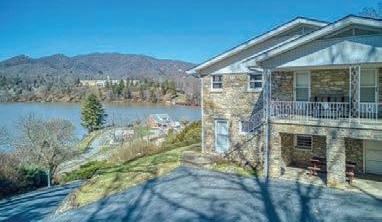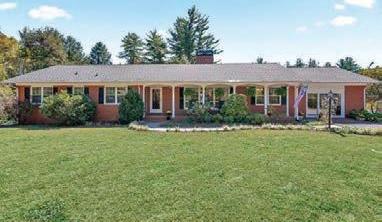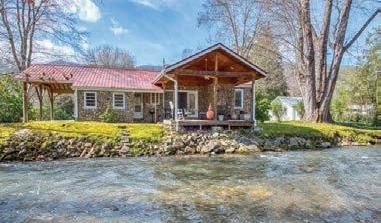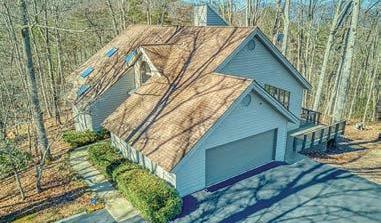
5 minute read
Back Then
OLD STONE WALLS “An entire book might be written about the natural history of an old stone wall.” — Edwin Way Teale, A Naturalist
Buys An Old Farm (1974) W e are attracted to those places where the forces of the natural and human worlds have come to terms with one another and live in harmony: dilapidated barns chocked full of hay; longestablished but abandoned garden spots that produce showy perennials year to year on their own; and homesteads by a creek with lamplight gleaming in the window, smoke curling upward into the starry night.
Old stone walls are the epitome of this sort of balanced existence. Built with hard labor and real care by human hands using the most basic of materials, the stone walls that trace the woodlands and fields here in the mountains often assume a life of their own, existing somewhere between man’s Columnist George Ellison
obvious utilitarian desires and nature’s sly chaos. A stone wall that once stood up the creek from our place here on the southern slope of the Smokies near the national park boundary line was typical of most such structures.
It was surely nothing special to look at. About 50 feet in length and several feet high and wide, it wasn’t a pretentious structure by any means. Even as walls go, it was a pretty quiet wall. But it was also a clear sign of some previous family’s attempt to make a permanent statement about their residence in and care for a particular patch of ground. The wall lined a footpath that wound up the creek through a small wooded area to where a footbridge once led out into the “real” world.
These days the “real” world has encompassed that wooded area. Some years ago we spent an afternoon with a chainsaw, hoes, and bare hands reclaiming the wall from honeysuckle and poison ivy vines. Many of the stone walls and piles up on the slopes above the valley were built as a way to stack and remove field stones from areas planted in crops, mostly corn. Beyond serving as refuse areas and ways to prevent soil erosion, they are not especially attractive. But the wall through the woodland beside the creek was built as a way to
BACK THEN
define a quiet pathway — a link — between the fields and the various homesteads. It was a calculated down-to-earth rural project that was also a spiritual statement of sorts.
John Burroughs, my favorite 19th century naturalist, once observed in an essay titled “Notes By The Way” that he “often thought what a chapter of natural history might be written on ‘Life Under a Stone,’ so many of our smaller creatures take refuge there — ants, crickets, spiders, wasps, bumblebees, the solitary bee, mice, toads, snakes, and newts. What do these things do in a country without stones? A stone makes a good roof, a good shield; it is waterproof and fire-proof, and, until the season becomes too rigorous, frost-proof, too. The field mouse wants no better place to nest than beneath a large, flat stone, and the bumblebee is entirely satisfied if she can get possession of a mouse’s old or abandoned quarters.”
Burroughs was writing about stones in general, of course, but his observations would also apply to stone walls, which are — in my opinion — incomplete without chipmunks. I always hoped a pair would take up residence in this partially tumbleddown stone wall, but they never did. Copperheads lived there. And skinks and mice. Crusted, flat lichens decorated the stones, creating fantastic maps with their doily-like patterns. Some of these slowgrowing lichen patches were so large they obviously predated the wall-building itself by centuries. They were perhaps there when the first Indians walked the watershed we now reside in thousands of years ago.
When I paused and studied the wall, it was difficult to discern just where the soil of the pathway ended and the lichensplotched stone began. These two entities had gradually assimilated, blended, and become one. This path and wall become a part of our family’s everyday existence — a designated wayfare for coming and going by daylight or starlight or moonlight. Even when we didn’t notice the wall, it ordered an important portion of our lives by its very presence. It was a soothing, undemanding, stable presence that was always there and would always be there, I supposed. After all, what can happen to a stone wall? In a single day — less than eight hours — the wall was obliterated by a bulldozer. The new owner of the land above ours on the creek cleared the area for rental cabins. It wasn’t our land or our wall. I don’t regret that I didn’t take a photograph. The sun-dappled pathway and its quiet border of hand-laid stones live on in our memories and those of our children. That’s a species of immortality, I suppose. (George Ellison is a writer and naturalist who lives in Bryson City. info@georgeellison.com.)
FOR SALE
MLS# 3592961 • $545,000


FOR SALE FOR SALE

MLS# 3554572 • $487,500


FOR SALE
Clyde • $245,000


UNDER CONTRACT
Waynesville • $239,000


NEW LISTING
We chose Pamela Williams to represent the listing of our historic home and, suffice to say, it was one of the best decisions we've ever made. Pamela's skilled marketing plans and the results she consistently achieves speak for themselves, and she did not fall short of the mark in the presentation of our home. She was punctual, articulate, completely prepared, and knocked the socks off of the competition. Professional photography showcased our property, and her marketing plan was well crafted with considerable time and effort involved. Her dedication paid off handsomely...she produced an acceptable offer within 48 hours of listing. In a transaction that presented numerous challenges, Pamela handled both sides of the transaction with great skill and transparency for all parties involved. Pamela is exemplary of the gold standard reputation of Beverly-Hanks within our local real estate community. We will hire her services again, without hesitation, for our future home sales and purchases." - Mr. Chastain “
RESIDENTIAL AND COMMERCIAL BROKER ASSOCIATE Pamela Williams












